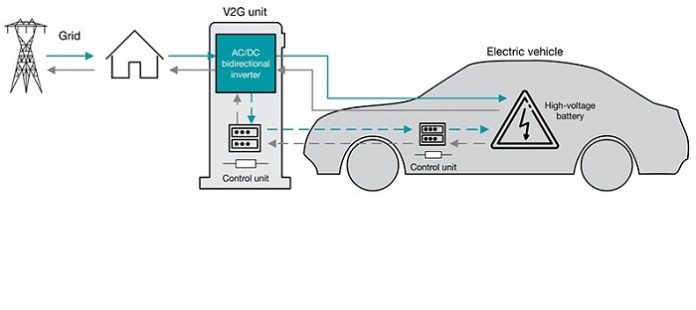Available for both commercial and residential use, a typical electric vehicle (EV) charging station design includes energy metering, AC and DC residual current detection, isolation for safety compliance, relays and contactors with drive, two-way communication, and service and user interfaces. While the goal of a charging station is to efficiently transfer power to a vehicle, implementing that power transfer is just the beginning of its role.
By 2030, an estimated 20 million public EV charging stations will connect to the grid, with residential charging stations expected to scale significantly to parallel the demand, according to recent reports from IHS Markit. An EV charging station design includes unique challenges. Electric vehicle supply equipment (EVSE) must incorporate communication, safety and security, while providing an easy upgrade path in order to accommodate the future of grid integration. In this article, I’ll briefly introduce 3 design considerations used in a scalable hardware and software demo using TI’s Sitara AM625 processor for a Level 2 AC EV charging station.
Design consideration No. 1: Understanding future communication standards and grid integration
Future EVs are expected to serve as energy sources by returning stored energy back to the grid during periods of high demand or power outages. Managing this potential exchange of energy is an aspect of grid integration that makes communication a critical design consideration in EV charging stations. For both the vehicle charging point to the grid, as well as the charging station to the cloud, the front- and back-end communication design must meet standards for data, safety and security in the charging process, as shown in Figure 1.

Figure 1: V2G technology
The International Organization for Standardization (ISO) 15118 standard outlines a bidirectional communication protocol between the EV and charging station, enabling the exchange of information for car identification, charge control and charging status to enable features such as plug and charge. Incorporating front- and back-end communication requirements to meet ISO 15118 standards enables compliance today and design longevity for the future of grid integration.
Selecting the right level of processor integration and software capability today can enable simple optimization for grid integration tomorrow. The Sitara AM625 used in the EV charging design shown in Figure 2 includes a mainline Linux kernel with a standard software development kit to ensure efficient maintenance and simplified updates. The AM625 processor also supports secure boot for IP protection with a built-in hardware security module (HSM), and employs advanced power-management support to optimize system power consumption when idle.


Figure 2: AC charger block diagram; DC charger block diagram
Design consideration No. 2: Leverage a module-based design for flexible AC or DC charging options
Determining the most appropriate connectivity solution for an EV charger includes consideration of its use case, the environment in which it will be installed, and scaling for grid integration. Commercial EV chargers typically require cloud connectivity to manage billing distribution as well as car data insights, and you may need to consider the potential of centralized data management between multiple charging points. Residential chargers will ultimately be an extension of a smart home and will need to integrate with existing wired and wireless networks.
The Open Charge Point Protocol (OCPP) is the standard of communication defined between charging stations and the charging station network that manages data exchange. Designing for this protocol requires options for multiple connectivity and is achievable with Ethernet, cellular, Wi-Fi® or Sub-1 GHz signals.
To address the challenge of flexibility with OCPP readiness, EV chargers need to have multiple connectivity options. For example, WiFi is ubiquitous. So, it can be used to connect EV charger to existing infrastructure or provide local connectivity for charging station network where wired connection is not feasible. When EV chargers are deployed in challenging RF environments like underground parking garages, lower frequency communication like Sub-1GHz is better than LTE for connection reliability. Regardless of whether the design is for commercial or residential use, or the location of the charger, the design will need a connectivity solution that is flexible and reliable.
Choosing the right connectivity solution means supporting higher operating temperature ranges ensure stable connection even in harshest environments with significant temperature changes. Also ensuring interoperability with commercial or home networks. The WL1837MOD WiLink 8 module from TI offers excellent RF performance and robust interoperability with other WiFi devices. It also has integrated Bluetooth for easy provisioning and deployment. Coupled with the production-ready Phycor-am62x multicore Arm-based processor system-on-module from Phytec, the WL1837MOD offers both ecosystem software compatibility for easy third-party software integration and an upgrade path for future migration and optimization of OCPP 2.0.1 and above.
Design consideration No. 3: Managing longevity with security and safety options.
With the future of ISO 15118 and OCPP 2.0.1 evolving toward increasing data insights for both vehicle and user data, secure software is essential for both connectivity and communication. The processor will play a key role in enabling a scalable future for EV charging, acting as a combination of system monitor for data quality and charging levels while providing a secure gateway for insights into payment and vehicle data.
Both the application and transport layers of ISO 15118 enable data security. Transport Layer Security (TLS) 1.2 or higher encrypts the transport layer communication. Although ISO 15118-2’s TLS is only mandatory when using the plug-and-charge identification mechanism, TLS is mandatory in the future ISO 15118-20 standard for all use cases and all identification mechanisms. The AM625 has onboard HSM security features such as:
- Secure boot:
- Self-programmable hardware (eFuse) keys.
- Support for encrypted and authenticated boot.
- Debugging (Joint Action Group) port:
- Closed by default on high-security devices.
- An eFuse setting allows permanent closure.
There are multiple aspects of safety built into every EV charging design, including secure cable connections, monitoring for ground faults, relay driving and high-voltage isolation. TI’s DRV8220 motor-driver integrated circuit has an integrated H-bridge, logic control and protection to enable simple implementations of plug locks, ground fault monitoring and relay drivers.
Conclusion
The EV charging industry is evolving, becoming more standardized, intelligent and efficient. Designers must include flexible connectivity and security to enable long-term integration with the grid. Selecting the right processor-based design necessitates consideration of increasing data-processing demands and the need for a reliable software stack.
Authored by:









